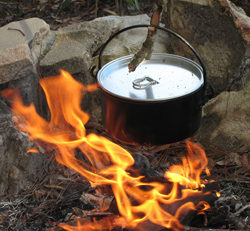As a frequent participant in Civil War re-enactments, I enjoy the opportunity to don clothes made out of wool and fire my 1861 Springfield replica. What I also enjoy is no cell phone, no iPad… no electronics at all…
Call it nostalgic, but it’s attractive to escape to this simpler life. Note, however, that simpler does not necessarily mean easier. It’s fun to cook over an open fire, and the food always tastes great, but it’s also a lot more work and requires significant planning.
O.K., enough about living like its 1865… How does any of this apply to today? It’s simple. I really mean it is simple!
When approaching church production, all too often we get way too caught up caught up in the electronics, the tools, the gear. But speaking as someone who can’t seem to be without his iPad unless he’s doing Civil War stuff, I also see tremendous value in stepping back and savoring the more simple things.
How do we put this into practice?
1) Have the worship team, on occasion, perform an acoustic set with minimal instrumentation. When we do this, I still amplify the instruments so they can be heard by the audience, but it’s much quieter and less complex. The focus is more on the music and the message, rather than on the technical aspects.
2) “Zero out” the console and start over, using as little EQ and effects as possible. I do this three or four times a year, making sure there’s ample rehearsal time to dial things back in. The benefit of this act of “starting over” makes me to think and rethink my approaches to EQ, compression, effects and so on. Typically I am able to identify and clean up some areas where I’ve been over-processing.
3) Use fewer microphones. In general, again, this makes me think harder about what I am doing and why. A specific example happened recently, when we had a touring act that was going to arrive in the middle of our Sunday morning service and do the closing song without a sound check. To top it off, the drummer was left handed so we had to set up another drum kit.
Being short of mics (and time), I chose to deploy the mics in a typical kick-snare-overhead setup, and figured that I would fully mic the set for the concert that night when I had more time and could borrow more mics from our youth room.
But what I found during the service, I found the simpler approach to be perfect. Plenty of of gain before feedback, and his kit sounded fantastic. I kept it the same for the concert.
4) Reset the stage so the musicians are closer together and need less monitor. I initially was doing this for a different look on stage, and found a great side benefit – stage volume usually decreases significantly. Specifically, I “cluster” the musicians as tight together as practical and then provide side fill monitors for the band and a single wedge for the vocalists.
The proximity of the band to each other allows them to hear each other better, and because the area they’re in is smaller, side fill monitors are easily able to do the job.
After my weekends of Civil War simplicity, I find that I’m quite ready to enjoy modern conveniences again. The same goes with my work with church sound.
In both cases, it provides much-needed focus and perspective, and helps me better appreciate and understand how to take advantage of all of the wonderful technology that’s available. And when not to…
Gary Zandstra is a professional AV systems integrator with Parkway Electric and has been involved with sound at his church for more than 25 years.


















